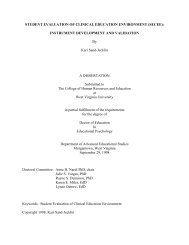Coach and Athlete Burnout - West Virginia University
Coach and Athlete Burnout - West Virginia University
Coach and Athlete Burnout - West Virginia University
You also want an ePaper? Increase the reach of your titles
YUMPU automatically turns print PDFs into web optimized ePapers that Google loves.
(.89) <strong>and</strong> intensity (.86), depersonalization’s frequency (.77) <strong>and</strong> intensity (.72), <strong>and</strong><br />
personal accomplishment’s frequency (.74) <strong>and</strong> intensity (.74). The authors also<br />
<strong>Burnout</strong> 91<br />
demonstrated sufficient test-retest reliability using a time interval of two-four weeks. All<br />
reliability coefficients for the subscales’ frequency <strong>and</strong> intensity were above .60.<br />
Maslach <strong>and</strong> Jackson (1981) established adequate convergent validity of the<br />
inventory in three ways. Scores on the MBI were correlated with the following criteria:<br />
independent behavior ratings by a person who knew the subject well, the presence of job<br />
characteristics likely to contribute to burnout, <strong>and</strong> measures of outcomes hypothesized to<br />
relate to burnout. To establish discriminant validity, scores on the MBI <strong>and</strong> an inventory<br />
measuring job satisfaction were correlated. The results indicated that less than six<br />
percent of variance was accounted for by the correlations, indicating that the MBI is not<br />
measuring the construct of job satisfaction, thus providing support for the inventory’s<br />
discriminant validity.<br />
Research outside of the sport realm has further examined the psychometric<br />
properties <strong>and</strong> efficacy of the MBI. Densten’s (2001) examination of the MBI’s<br />
conceptualization <strong>and</strong> psychometric properties generated a five-factor structure opposed<br />
to the original three-factor design. The research supported emotional exhaustion splitting<br />
into psychological <strong>and</strong> somatic strain components. Further, the personal accomplishment<br />
subscale was broken down into lack of self <strong>and</strong> others.<br />
Wright <strong>and</strong> Bonett (1997) tested the relationships between the three dimensions of<br />
the MBI with work performance. Their results only yielded a significant negative<br />
relationship between the emotional exhaustion subscale <strong>and</strong> work performance. The<br />
study’s longitudinal design confirmed the need for future longitudinal burnout designs












